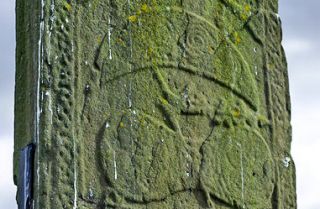
There are figures of strange beasts and four mounted men hunting with hounds, but the unusual - and almost unique - feature of St Orland's Stone is a Pictish boat carrying passengers. This is one of only a very few carvings showing what a Pictish boat looked like. The only other known carvings of boats from this period have been found at Jarlshof in Shetland, and on cave walls at East Wemyss in Fife.
The stone is 7'10" tall and 2'4" wide. It stands in a field 2 miles from Glamis, thought to be a centre of Pictish religious activity. Archaeological excavations revealed that the stone is very likely in its original position, and at the base of the stone remains of 5 cist burials were discovered. One possibility is that a chapel stood at this spot during the Pictish period.
Visiting
Access to the stone can be a challenge. The best route is to take the rough track signposted Meikle Cossans, off the A928 2 miles north of Glamis. Keep your eyes open; the track is easy to miss! Park at the ruined Cossans farm and follow the line of a disused railway track before branching right along a field boundary, and over a stile in a deer fence. I highly recommend taking along a good OS map! OS Landranger 54 should do the trick.
 We've 'tagged' this attraction information to help you find related historic attractions and learn more about major time periods mentioned.
We've 'tagged' this attraction information to help you find related historic attractions and learn more about major time periods mentioned.




